This IPL season has brought in two rule changes that are meant to help bowlers. But they've ended up creating a tricky choice for the captains.
Old ball or dry ball: The death-over dilemma for captains

One brings back the use of saliva to shine the ball and use reverse swing. The other rule allows the fielding captain to replace the ball with one of "similar wear and tear" after the 10th over in the second innings of a night game, even in the absence of visible dew. In effect, teams can now swap a soft and/or damp ball for a harder and drier one.
While both the rules were introduced to balance the skewed bat-ball dynamic, they can be at odds with each other in practice. If you've worked on the ball all innings to get it to reverse, do you stick with it? Or do you opt for another one that might buy your spinner more grip and turn in the final 10 overs of the match?
The conundrum came into play in Match #5 between Punjab Kings and Gujarat Titans. Shreyas Iyer chose not to change the ball and the plan to bowl wide yorkers from over-the-wicket to Sherfane Rutherford bore fruit. "Arshdeep played an important role in that (the wide yorker plan)," Shreyas revealed after the match. "He came in and said the ball is actually reversing a bit, so the saliva on the ball is helping the bowlers a bit I guess. He got Sai [Sudharsan] and that changed the momentum for us, and then he came in and said let's start the wide yorkers earlier than trying it too late."
Punjab's fast bowling coach James Hopes explained the thinking behind it, but also underlined the trade-off. "Arshdeep enjoyed it, he was going to work on the ball properly with saliva and we did get a little bit of [reverse] swing in that last game at the end. But to be fair, that came at the expense of getting a dry ball as well because we didn't change our ball, and that probably affected Yuzi [Yuzvendra Chahal] a little bit as well because he wasn't bowling with the dry ball for that game," Hope said.
A few days later, Royal Challengers Bengaluru did the opposite. In their win over Chennai Super Kings in Chennai, they changed the ball before the 20th over and handed it to Krunal Pandya. The game was already effectively lost by then, so it may not have made a big difference but it showed another way to use the rule. On some pitches where the ball grips, giving your spinner a dry, hard ball at the end can be a smart move. It's a strategy that might be used more often as teams get used to the new rules.
In contrast, Shreyas's decision to not opt for the harder ball meant that Yuzvendra Chahal, who was bought by PBKS at a record-breaking INR 18 crore, making him the most expensive specialist spinner in IPL history, wasn't even able to complete his quota of overs. It was a surprising call, given that Chahal had been brought in specifically to address the team's long-standing spin bowling struggles. For context, PBKS had one of the weakest spin attacks in the last cycle, with Rahul Chahar unable to replicate the success he had at Mumbai Indians. So when they broke the bank for Chahal, it was with the clear intent of giving their spin department a reliable match-winner.
But for that to work, the conditions have to suit him. And that's where the ball change rule becomes a strategic call.
"So we have to weigh up what we're going to need the most," Hope explained. "Whether we're going to need to try and get a little bit of tail with the older ball or whether we're going to need to give our world-class spinner a dry ball to make an impact within the last 10 overs. So we're going to have to weigh that up game to game based on conditions."
And when you're up against big hitters like Nicholas Pooran, these decisions matter even more.
"I think what we've seen on these grounds and on these pitches sometimes, someone like Pooran for example, he's had an unbelievable last two years. It's just about trying to limit the damage sometimes," Hopes said. "You're really aggressive with him in his first five or six balls and you're trying to get him out. Then it's almost what you've seen teams doing, they're trying to shut the game down in the seventh over. They're bowling yorkers straight away. They're not waiting until the 15th over. We had a guy come in the last game and bowl yorkers from the first ball he bowled and try to bowl 18 of them in a row.
"You've got to expect there's going to be fours and sixes. Just trying to limit the damage all the time," Hopes added.
As the tournament progresses and dew patterns vary across venues deep into the summer, how captains negotiate this conundrum will be something to watch out for, especially on nights where a single over can tilt the contest.
| Share | Tweet |





